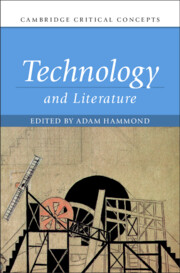Book contents
- Technology and Literature
- Cambridge Critical Concepts
- Technology and Literature
- Copyright page
- Contents
- Figures
- Contributors
- Timeline
- Introduction
- Part I Origins
- Part II Developments
- Chapter 8 Prostheses
- Chapter 9 Clocks
- Chapter 10 Compasses
- Chapter 11 Telescopes
- Chapter 12 Steam Engines
- Chapter 13 Wires
- Chapter 14 Cameras
- Chapter 15 Phonographs
- Chapter 16 Waves and Rays
- Chapter 17 The Bomb
- Chapter 18 Networks
- Part III Applications
- Index
Chapter 13 - Wires
from Part II - Developments
Published online by Cambridge University Press: 30 November 2023
- Technology and Literature
- Cambridge Critical Concepts
- Technology and Literature
- Copyright page
- Contents
- Figures
- Contributors
- Timeline
- Introduction
- Part I Origins
- Part II Developments
- Chapter 8 Prostheses
- Chapter 9 Clocks
- Chapter 10 Compasses
- Chapter 11 Telescopes
- Chapter 12 Steam Engines
- Chapter 13 Wires
- Chapter 14 Cameras
- Chapter 15 Phonographs
- Chapter 16 Waves and Rays
- Chapter 17 The Bomb
- Chapter 18 Networks
- Part III Applications
- Index
Summary
This chapter investigates the ways in which writers used the rapidly expanding wired networks of electrical communications technologies such as the telegraph and the telephone to reimagine notions of community, nation, and empire in the nineteenth and early twentieth centuries. The development of electrical communication networks was motivated by, and in turn enabled, the spread of empire in the nineteenth and twentieth centuries, establishing models of center and periphery in stark contrast with utopian predictions of global interconnection. Worth shows how telegraph and telephone wires were conceived not only as nerves connecting the globe, but also, acting as the circulatory system of Empire, as veins or arteries – “metaphorical carrier[s] not only of information but of blood.” In addition to establishing wired networks of earthly dominion, the telephone and telegraph opened imaginary connections into the uncanny and the otherworldly, seeming to transgress the boundary between life and death.
- Type
- Chapter
- Information
- Technology and Literature , pp. 251 - 268Publisher: Cambridge University PressPrint publication year: 2023

